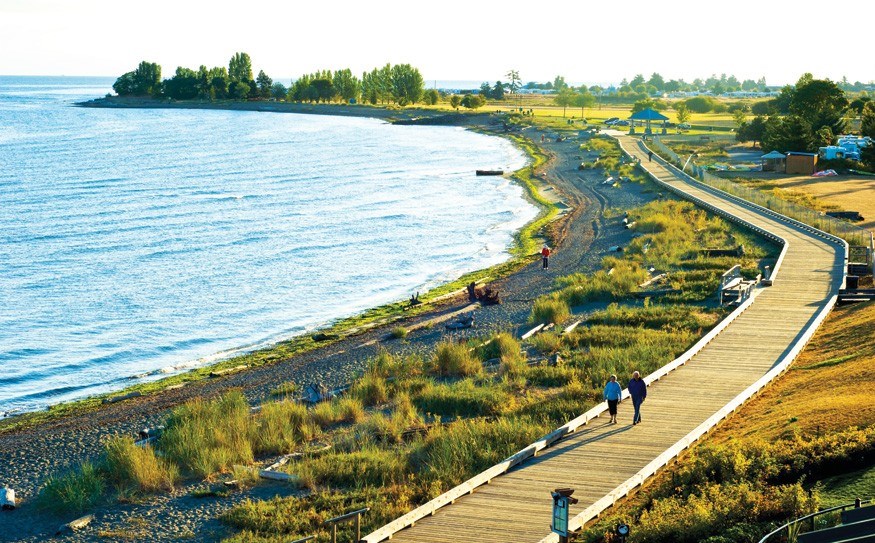As a city dweller, I put out of my mind the power of natural terrain and great vistas to impress and calm. But I was reminded on a recent stay in Parksville, on Vancouver Island how nature has the power to renew almost effortlessly.
From a fourth-storey suite at the Beach Club Resort, one looks over natural grasses and haphazardly strewn logs to a tidal flat dotted with pools and rivulets, the lively waters of Georgia Straight and, on the horizon, Lasqueti Island and the coastal mountains. When the tide's in at night, the scene is utter serenity.
And there's more to this region—from Nanoose Bay in the south through Parksville and Qualicum to Bowser Bay in the north—than an ever-changing ocean panorama.
Of course, you can park yourself on a beachfront and take to the waters. As the tide came in late one afternoon, I watched a half dozen people literally hold their stake on a slightly raised sandbar, Robinson-Crusoe-like, until the waters forced them to wade ashore. Parksville Bay and Rathtrevor Beach, to the south, are beloved for these vast sand-slash-mud flats, temporary shallows, and activities that range from san-castle building to every kind of board sport you can imagine.
Somewhat stonier Qualicum Beach is perfectly picturesque. And while the Beach Club Resort and other area accommodation may be classified (and priced) as luxury, there are hotel and motels for under $100 a night—particularly in the shoulder and winter seasons—all along the beachfront on what's been dubbed the Oceanside Route.
An enticing wilderness of forest, lakes and mountain streams lie behind this eastern shore, so I motored up Highway 4A toward Alberni to Little Qualicum Falls where, at the foot of a long set of steep steps, a tempestuous river tumbles through several gorge-like narrows. I felt like I'd been dropped into another realm — nothing but wild water and every shade of green, dappled with sunlight.
Another paean to nature is the Milner Gardens and Woodlands on the Qualicum Bay waterfront. Established in the late 1920s by lawyer and businessman Ray Milner and his wife Rina, the 70-acre site has evolved into a jewel of a walkable forest, and plantings from around the world collected by Milner and his second wife, an Irish aristocrat.
Today the gardens are a haven of old rhododendron and hydrangea trees — many, in late summer, looking like wiry modern art. The sprawling plantation-style house, in which the Queen and Prince Philip once stayed, is now a lovely teahouse. But the glory is in the ocean-air gardens, in which, for example, a stream, running down a rockery padded with mosses and given a Japanese motif, blends the best of the West Coast with the exotic East.
A particular delight in Qualicum is the (seasonal) Saturday Farmers' Market, nestled in the well-treed lee of the former Esquimalt & Nanaimo Railway line tracks.
I chatted with a young farmer who had produced half a dozen varieties of chard and kale, yellow and red heirloom tomatoes and much else. From a Denman Island orchardist I bought (blessedly) small heritage apples. And there was a run on gooey cinnamon buns in the artisan bakery lineup.
Vendor artist-creator Bruce Bentley explained how he picks pieces of sculpted driftwood from Oyster Bay near Campbell River, and incorporates them into small, roofed birdhouses (admittedly more attractive than utilitarian). Glorious bundles of freshly cut flowers rounded out this low-key, friendly affair.
Speaking of oysters, one evening I slipped into the DeeZ Bar and Grill on Qualicum Beach for a grilled oyster burger. At $11 for entrée with salad, and $7 for a good glass of Sauvignon Blanc, it was a bargain. The delicious oysters, said the server, came from Fanny Bay, along Highway 19, north to Courtenay-Comox.
Back in Parksville, I found the Craig Heritage Park Museum & Archives near the entrance to town on the East Island Highway (19A). A cluster of buildings includes the 100-year-old French Creek Post Office, a simple cedar-log building with beautiful dove-tailing; the Montrose School, containing a coal stove used on the E & N Railway; and the McMillian House (circa 1885), with a glorious fieldstone fireplace, over which hangs an old-fashioned homily: "The Lord is faithful, and shall stabilize you and keep you from evil."
But the most notable artifact was the small, rustic cabin that once housed the James Craig family at Craig's On the Sea Auto Camp in Parksville. The 15-cabin "resort" operated from the early 1930s until the 1980s—surely one of the earliest expressions of automobile tourism in an area sometimes referred to (presumably for the tolerable waters, not the glamour) as "Canada's Riviera."
To be fair, there was a good dollop of glamour back at the Beach Club Resort on the Labour Day weekend for the annual "Bubbles on the Beach" party. Martinis, wine tasting, a roast sucking pig (served in "pork sliders") and oysters on the half-shell started off an event that morphed into a luscious night of chatter and dancing illuminated by gas lanterns and a star-studded sky. One wonders what auto-camp founder James Craig (1863-1946) would have made of it all.




